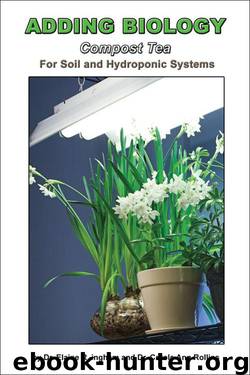Adding Biology for Soil and Hydroponic Systems by Carole Ann Rollins Ph.d. & Ph.d. Carole Ann Rollins & Ph.d. Elaine Ingham

Author:Carole Ann Rollins Ph.d. & Ph.d. Carole Ann Rollins & Ph.d. Elaine Ingham [Rollins, Carole Ann Ph.D. & Rollins, Ph.D. Carole Ann & Ingham, Ph.D. Elaine]
Language: eng
Format: epub
Tags: Crafts; Hobbies & Home, Gardening & Landscape Design, By Technique, Urban, Gardening & Horticulture, Techniques
Amazon: B001PTG6LM
Publisher: Environment Celebration Institute
Published: 2006-05-02T04:00:00+00:00
_________________________________________________________________________________________________________
The plant selects and feeds those organisms that prevent diseases around its roots, leaves, stems, etc.
Diversity of Microorganism Community Essential The total number of species, as well as abundance of species, are a measure of diversity of a community of organisms. The number of functional groups of organisms in any plant growing environment is a measure of functional diversity. A wide diversity of species of each functional group is needed because the environment, at any given time, selects for the growth of a very limited set of those species. The environmental conditions will be right for some species of organisms to be working, while others will be asleep. A few to several hundred will match the growth conditions at any moment, so thousands of species of each functional group are needed. The plant selects and feeds those organisms that prevent diseases around its roots, leaves, stems, etc. We do not know the names of all these organisms, but we do know that their numbers in the right quantities work to suppress disease, retain nutrients, and decompose residues. If there are active, functioning, beneficial species for each set of conditions throughout the year, then diseases or pests cannot get established. Diverse sets of organisms will outcompete disease pathogens and pests for food and space, and occupy potential infection sites. For this healthy competition to occur 60-70% of the plant surface (leaf, stem or roots) must be covered with bacteria and 2-5% must be covered with fungi.
_________________________________________________________________________________________________________
Bacteria and Fungi Retain Nutrients Calcium is retained as crystals on the surface of the fungal hyphae (threads that form the fungi). Other nutrients are also retained in this same manner. Plants cannot get access to nutrients retained by the bacteria or fungi directly; they need protozoa and nematodes to consume them and release the nutrients in a plant-available form. The metabolic processing in protozoa and nematodes transform and chelate these nutrients, which are then released in their waste. The nutrients are then in a plant-available form, ready for plant uptake.
CALCIUM ON FUNGI: Scanning electron micrograph of compost fungi. The crystalline structures on the fungi are calcium oxalate, held and prevented from leaching out of the soil. Mycorrhizal fungi can translocate this calcium directly to the plant. Other fungi will need to be consumed by nematodes or microarthropods to release the calcium in a chelated form for plant uptake. (Photo courtesy of Graham Lancaster and Soil Foodweb Inc.)
Download
This site does not store any files on its server. We only index and link to content provided by other sites. Please contact the content providers to delete copyright contents if any and email us, we'll remove relevant links or contents immediately.
Turbulence by E. J. Noyes(7918)
The Thirst by Nesbo Jo(6806)
Gerald's Game by Stephen King(4554)
Be in a Treehouse by Pete Nelson(3922)
Marijuana Grower's Handbook by Ed Rosenthal(3605)
The Sprouting Book by Ann Wigmore(3529)
The Red Files by Lee Winter(3356)
The Remains of the Day by Kazuo Ishiguro(3279)
Sharp Objects: A Novel by Gillian Flynn(2939)
Christian (The Protectors Book 1) by L. Ann Marie(2644)
Organic Mushroom Farming and Mycoremediation by Tradd Cotter(2616)
The Culinary Herbal by Susan Belsinger(2420)
Stone Building by Kevin Gardner(2336)
The Starter Garden Handbook by Alice Mary Alvrez(2269)
Lilac Girls by Martha Hall Kelly(2243)
The Unlikely Pilgrimage of Harold Fry by Rachel Joyce(2202)
The Lean Farm Guide to Growing Vegetables: More In-Depth Lean Techniques for Efficient Organic Production by Ben Hartman(2084)
Urban Farming by Thomas Fox(2054)
Backyard Woodland by Josh VanBrakle(1879)
